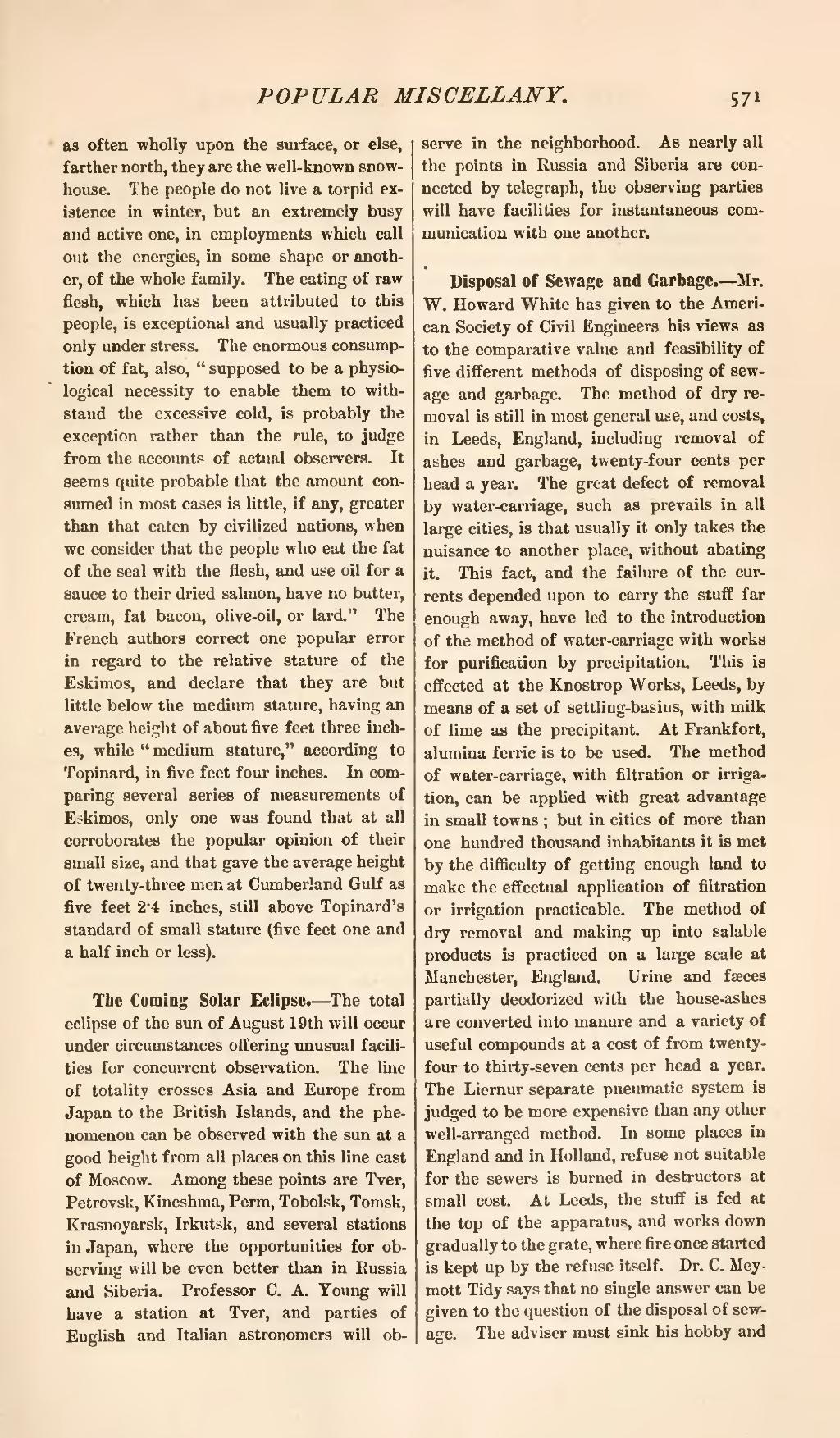as often wholly upon the surface, or else, farther north, they are the well-known snow-house. The people do not live a torpid existence in winter, but an extremely busy and active one, in employments which call out the energies, in some shape or another, of the whole family. The eating of raw flesh, which has been attributed to this people, is exceptional and usually practiced only under stress. The enormous consumption of fat, also, "supposed to be a physiological necessity to enable them to withstand the excessive cold, is probably the exception rather than the rule, to judge from the accounts of actual observers. It seems quite probable that the amount consumed in most cases is little, if any, greater than that eaten by civilized nations, when we consider that the people who eat the fat of the seal with the flesh, and use oil for a sauce to their dried salmon, have no butter, cream, fat bacon, olive-oil, or lard." The French authors correct one popular error in regard to the relative stature of the Eskimos, and declare that they are but little below the medium stature, having an average height of about five feet three inches, while "medium stature," according to Topinard, in five feet four inches. In comparing several series of measurements of Eskimos, only one was found that at all corroborates the popular opinion of their small size, and that gave the average height of twenty-three men at Cumberland Gulf as five feet 24 inches, still above Topinard's standard of small stature (five feet one and a half inch or less).
The Coming Solar Eclipse.—The total eclipse of the sun of August 19th will occur under circumstances offering unusual facilities for concurrent observation. The line of totality crosses Asia and Europe from Japan to the British Islands, and the phenomenon can be observed with the sun at a good height from all places on this line east of Moscow. Among these points are Tver, Petrovsk, Kineshma, Perm, Tobolsk, Tomsk, Krasnoyarsk, Irkutsk, and several stations in Japan, where the opportunities for observing will be even better than in Russia and Siberia. Professor C. A. Young will have a station at Tver, and parties of English and Italian astronomers will observe in the neighborhood. As nearly all the points in Russia and Siberia are connected by telegraph, the observing parties will have facilities for instantaneous communication with one another.
Disposal of Sewage and Garbage.—Mr. W. Howard White has given to the American Society of Civil Engineers his views as to the comparative value and feasibility of five different methods of disposing of sewage and garbage. The method of dry removal is still in most general use, and costs, in Leeds, England, including removal of ashes and garbage, twenty-four cents per head a year. The great defect of removal by water-carriage, such as prevails in all large cities, is that usually it only takes the nuisance to another place, without abating it. This fact, and the failure of the currents depended upon to carry the stuff far enough away, have led to the introduction of the method of water-carriage with works for purification by precipitation. This is effected at the Knostrop Works, Leeds, by means of a set of settling-basins, with milk of lime as the precipitant. At Frankfort, alumina ferric is to be used. The method of water-carriage, with filtration or irrigation, can be applied with great advantage in small towns; but in cities of more than one hundred thousand inhabitants it is met by the difficulty of getting enough land to make the effectual application of filtration or irrigation practicable. The method of dry removal and making up into salable products is practiced on a large scale at Manchester, England. Urine and fæces partially deodorized with the house-ashes are converted into manure and a variety of useful compounds at a cost of from twenty-four to thirty-seven cents per head a year. The Liernur separate pneumatic system is judged to be more expensive than any other well-arranged method. In some places in England and in Holland, refuse not suitable for the sewers is burned in destructors at small cost. At Leeds, the stuff is fed at the top of the apparatus, and works down gradually to the grate, where fire once started is kept up by the refuse itself. Dr. C. Meymott Tidy says that no single answer can be given to the question of the disposal of sewage. The adviser must sink his hobby and
